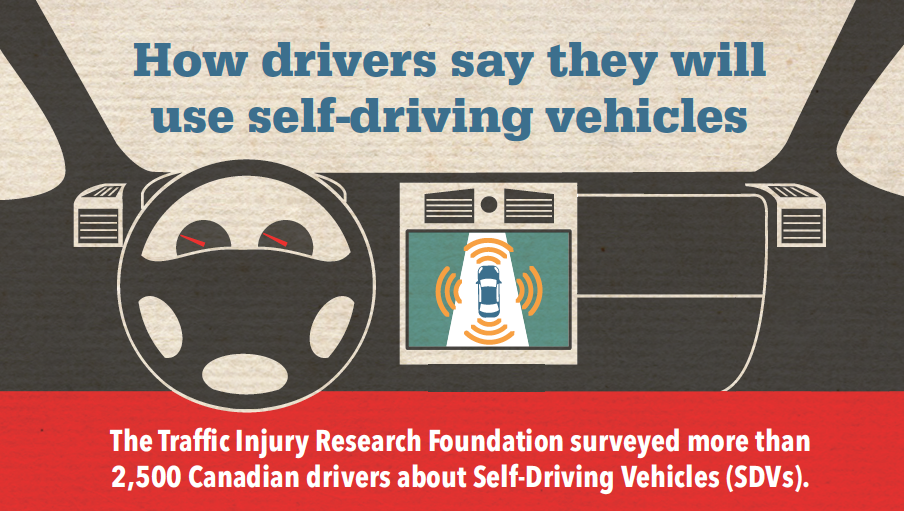Limited self-driving vehicles (SDVs) will be produced for consumer purchase as early as 2020. With advanced vehicle technologies emerging, everyone needs an increased understanding of how drivers will interact with these new systems. In late 2015, with funding from the Toyota Canada Foundation, the Traffic Injury Research Foundation (TIRF) developed a national poll to examine driver knowledge, attitudes, and practices in response to self-driving vehicles and automated vehicle (AV) technology. In May 2016, TIRF conducted the poll, surveying more than 2,500 Canadian drivers.
The poll was an extension of research for their Brain on Board program, which we helped TIRF brand back in early 2013. TIRF asked our team to develop an infographic to put their poll results into perspective, and show the content in a visually-appealing way.
Here’s what we came up with: Infographic– How drivers say they will use self-driving vehicles.
The most concerning statistics uncovered were that 16% of Canadians believed they would not have to be attentive when driving an SDV, 24% of drivers reported they would drive drowsy, and 17% would drive distracted. These numbers make it clear that more education is needed to ensure Canadians and all drivers are well-prepared for SDVs.
It’s important that Canadians remember SDV technology is meant to enhance a driver’s control of their vehicle, but it is not a replacement for knowledge and an attentive driver. Your brain is your vehicle’s most important safety feature!
For more information on drivers’ attitudes towards self-driving vehicles, download TIRF’s full report.
A version of this article originally appeared on acart.com.
The poll was an extension of research for their Brain on Board program, which we helped TIRF brand back in early 2013. TIRF asked our team to develop an infographic to put their poll results into perspective, and show the content in a visually-appealing way.
Here’s what we came up with: Infographic– How drivers say they will use self-driving vehicles.
The most concerning statistics uncovered were that 16% of Canadians believed they would not have to be attentive when driving an SDV, 24% of drivers reported they would drive drowsy, and 17% would drive distracted. These numbers make it clear that more education is needed to ensure Canadians and all drivers are well-prepared for SDVs.
It’s important that Canadians remember SDV technology is meant to enhance a driver’s control of their vehicle, but it is not a replacement for knowledge and an attentive driver. Your brain is your vehicle’s most important safety feature!
For more information on drivers’ attitudes towards self-driving vehicles, download TIRF’s full report.
A version of this article originally appeared on acart.com.


